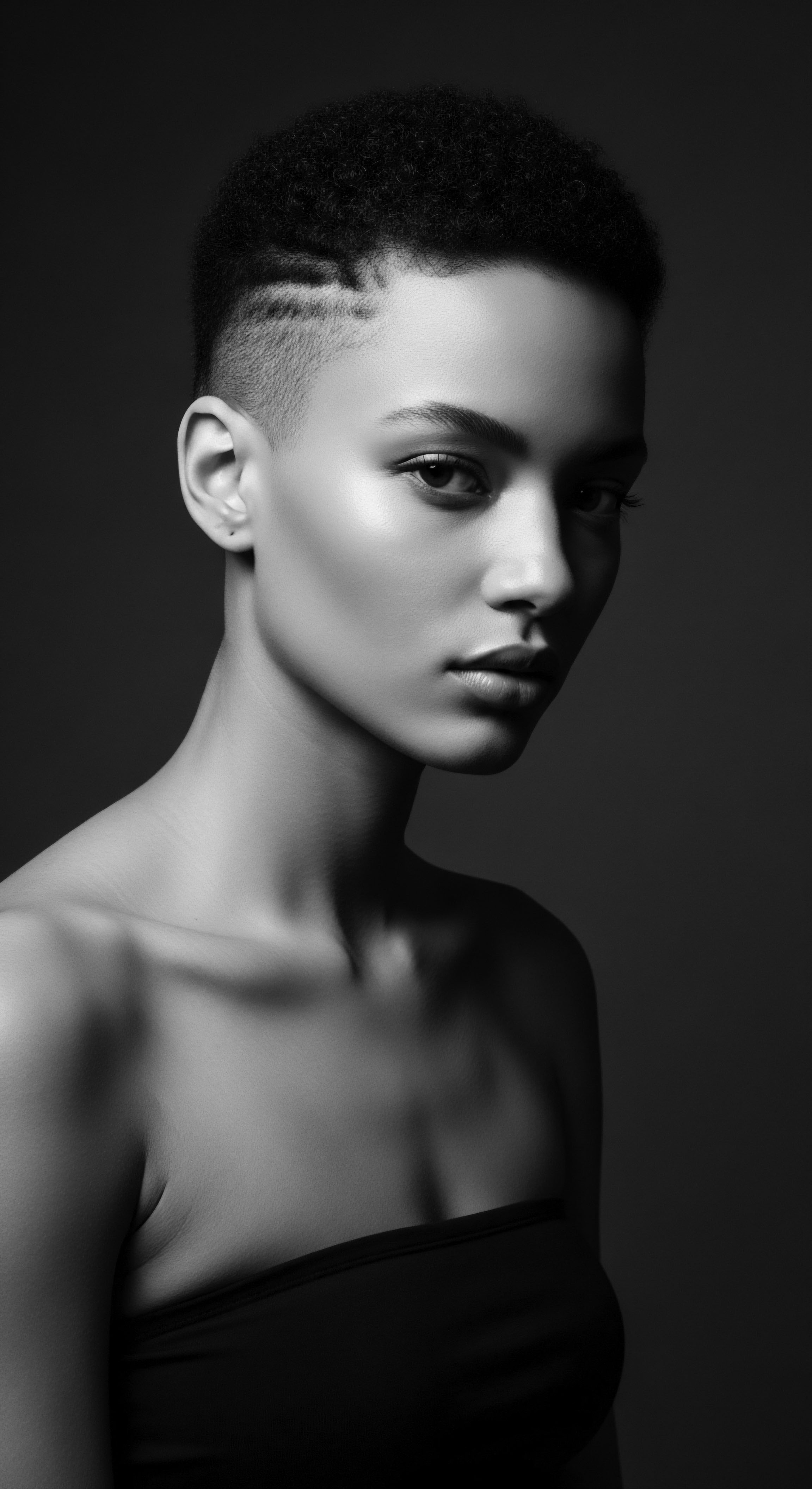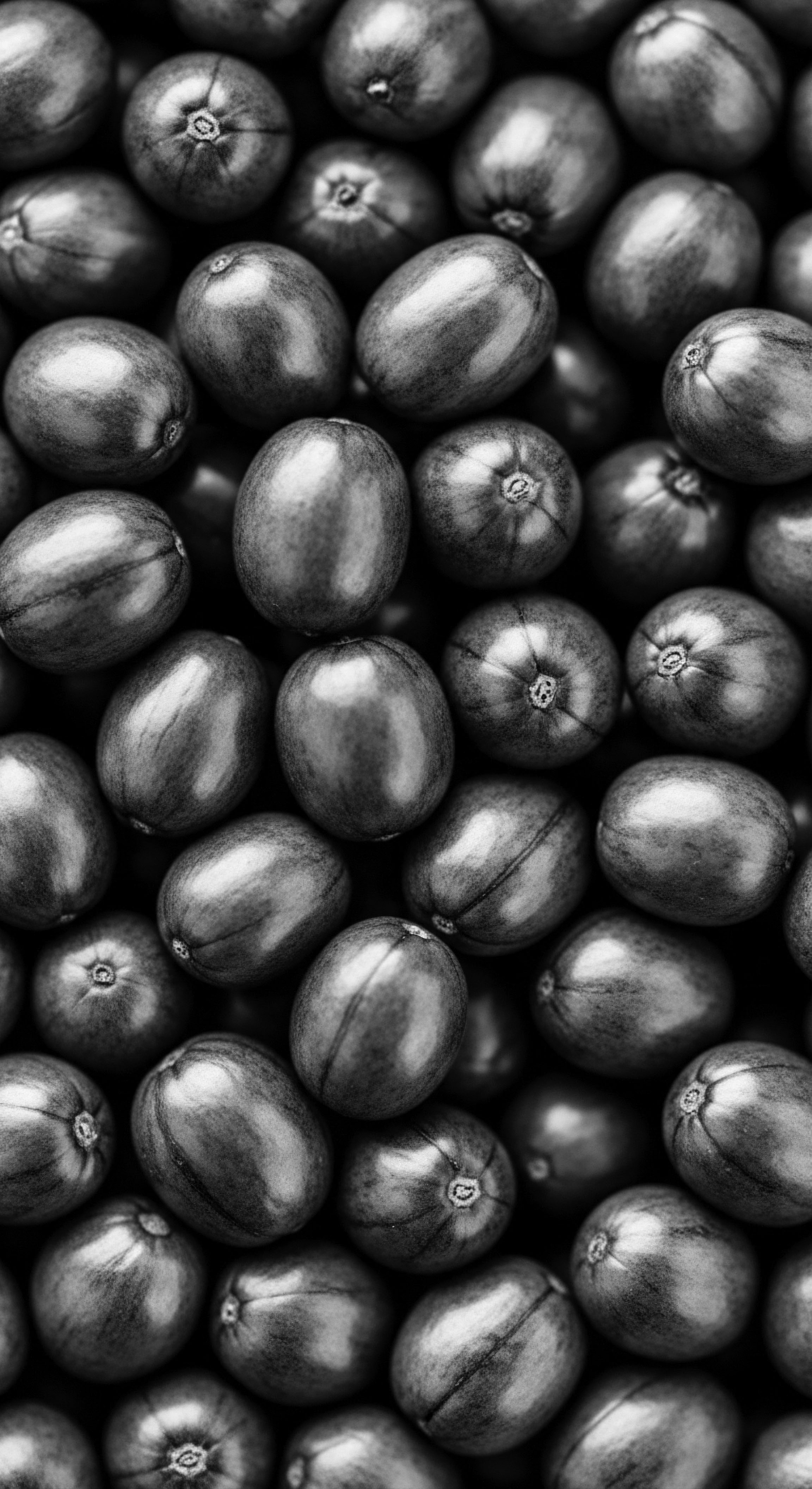
Fundamentals
The essence of the Feminine Principle, at its fundamental core, speaks to a profound receptivity, a yielding quality that enables life to unfurl and connections to deepen. It is an understanding that moves beyond simple biological distinctions, encompassing a deep sensitivity, an innate capacity for holding and nurturing. This principle is often associated with the very fabric of existence that welcomes, sustains, and transforms, much like the fertile earth receiving a seed or the quiet waters cradling life within their depths. Within the expansive narrative of textured hair, particularly for Black and mixed-race communities, this understanding of the Feminine Principle finds its earliest echoes.
Consider the earliest forms of care given to a child’s delicate coils, often a mother’s gentle touch, a grandmother’s patient detangling. This initial interaction embodies the receptive aspect of the Feminine Principle ❉ an openness to the inherent nature of the hair, allowing its unique spiral to express itself, rather than forcing it into rigid forms. It speaks to a soft yet strong presence, one that respects the natural cadence of growth and development. This fundamental relationship sets a foundation for how textured hair is perceived and treated, shaping it not merely as a physical attribute, but as a living extension of identity and lineage.
Ancestral wisdom consistently viewed hair, especially the rich and varied textures across African societies, as far more than mere adornment. It was considered a sacred conduit, a physical link to the divine and to the wisdom of those who walked before. This belief reflects the Feminine Principle’s spiritual dimension, acknowledging hair as an antenna, a receiver of energies, insights, and ancestral blessings. This perspective informs the very first touch, the earliest ritual of care, ensuring that attention to hair was simultaneously an act of reverence and an affirmation of spiritual continuity.
The Feminine Principle, in its most elemental form, signifies the profound, welcoming receptivity and nurturing capacity that allows existence to flourish and connections to deepen.
From ancient times, communities understood that the vitality of hair mirrored inner well-being and a connection to the collective spirit. The act of washing, oiling, and styling was not solely for aesthetic appeal; it represented a ritual of cleansing, protection, and infusion of positive intentions. This holistic approach, seeing the body and spirit as intertwined, aligns perfectly with the Feminine Principle’s inclination toward integration and interconnectedness. It encourages a deeper awareness of the energy flowing through each strand, linking the individual to the vast, unseen currents of heritage and spirituality.

Intermediate
Moving beyond the elemental, an intermediate understanding of the Feminine Principle reveals its dynamic role in creation, intuition, and the fostering of community, particularly visible within the textured hair heritage of Black and mixed-race individuals. This is where the principle begins to express itself as an active force, shaping not just reception, but also the informed action born of deep knowing. Here, the receptive capacity of the Feminine Principle transforms into an intuitive guidance, illuminating pathways of creation and care that honor inherent truth.
The communal aspect of hair care, a cherished tradition across the African diaspora, provides a living testament to the Feminine Principle. Gatherings on “wash days,” often stretching from morning until evening, were not merely chores; they were sacred social rituals. Mothers, grandmothers, aunts, and sisters would dedicate hours to detangling, moisturizing, and braiding younger generations’ hair.
This ritual extended beyond simple grooming; it was a profound opportunity for sharing techniques, transmitting stories of resilience, and instilling a deep sense of pride and identity. The intimate space created during these sessions, filled with soft chatter and shared wisdom, allowed for the subtle transfer of knowledge and affection, embodying the nurturing, connective flow of the Feminine Principle.
The very structure of textured hair, with its unique coils and curls, offers a biological mirror to the Feminine Principle. These diverse patterns demand a particular approach to care—one that prioritizes moisture, gentle handling, and protective styling over rigid manipulation. This mirrors the Feminine Principle’s preference for fluidity, adaptability, and an understanding that true strength often resides in flexibility and an honoring of natural form.
The Feminine Principle, in its intermediate expression, signifies active intuition, the creative impulse, and the profound communal ties forged through shared experience.
Throughout history, the artistry involved in styling textured hair became a potent form of non-verbal communication and cultural assertion. Intricate braids, twists, and locs served as a visual language, signifying age, marital status, social rank, tribal affiliation, and even spiritual beliefs. The elaborate nature of these styles, often requiring hours or even days to create, fostered patience, collaboration, and a deep appreciation for beauty that communicates meaning. This collective creative endeavor, rooted in ancestral practices, demonstrates how the Feminine Principle manifests through communal effort and the elevation of personal expression as a reflection of shared heritage.
- Oral Histories ❉ The stories shared during these hair sessions often recounted family histories, migrations, and triumphs, serving as a living archive of collective memory.
- Traditional Botanicals ❉ Ancestral hair care regimens frequently relied on local plants and natural oils, passed down through generations, embodying an intuitive knowledge of the earth’s restorative powers.
- Rites of Passage ❉ Specific hairstyles marked significant life stages, such as initiation into adulthood or marital status, symbolizing a profound connection between personal identity and communal tradition.
The resilience inherent in textured hair, its capacity to spring back, to defy attempts at rigid control, subtly reflects the enduring spirit of the Feminine Principle. This resilience is not aggressive; it is a persistent, gentle reclaiming of form, a constant return to its natural state. This characteristic has, throughout the ages, resonated deeply with the spirit of survival and adaptability that marks the journey of Black and mixed-race communities. It speaks to a deep, internal strength that can withstand immense pressure yet return to its authentic shape, much like water shaping stone through patient, continuous flow.

Academic
At an academic level, the Feminine Principle transcends simplistic gendered associations to denote a constellation of attributes and dynamics essential for holistic existence and flourishing. This delineation, often explored within philosophical traditions like Taoism and certain schools of psychology, describes an orienting force characterized by receptivity, intuition, interconnectedness, creation, and the capacity for deep emotional and relational intelligence. It is the ‘Yin’ to the ‘Yang,’ not as an opposite in opposition, but as a complementary pole enabling dynamic balance and continuous transformation within the universe. Here, the Feminine Principle is understood as an inherent aspect of consciousness, influencing perception and interaction with the world by favoring depth, synthesis, and an appreciation for the subtle, often unseen, currents of life.
In the context of textured hair heritage, this academic understanding of the Feminine Principle provides a robust lens through which to examine centuries of lived experience, resistance, and cultural preservation. The innate characteristics of Afro-textured hair—its coil, its volume, its need for moisture and gentle handling—echo the very attributes of the Feminine Principle ❉ a natural inclination toward self-expression, a requirement for respectful engagement, and an inherent strength found in its unique, often gravity-defying, forms. This contrasts sharply with Eurocentric beauty standards that historically sought to suppress or alter these natural inclinations, favoring linearity and submission over the organic spiral. Such historical pressures represent an attempted subjugation of the inherent Feminine Principle expressed through Black hair.
The academic interpretation of the Feminine Principle reveals a pervasive force of receptivity, intuition, and interconnectedness, providing an analytical framework for understanding the resilience and cultural significance of textured hair.

Hair as a Cartographic Canvas ❉ A Powerful Act of Feminine Ingenuity
A powerful historical instance illuminating the Feminine Principle’s connection to textured hair heritage arises from the harrowing period of transatlantic enslavement. During this time of profound dehumanization, African women, dispossessed of their names, lands, and languages, transformed their hair into a remarkable tool of survival and resistance. This stands as a testament to the intuitive, creative, and life-preserving aspects of the Feminine Principle.
Enslaved women, particularly those forced to labor in rice fields across regions like Colombia and Brazil, meticulously braided rice grains, seeds, and even gold dust into their intricate cornrows. These concealed provisions served as vital resources for sustenance during perilous escape attempts or for cultivating new life in foreign, hostile lands.
The brilliance of this practice extends beyond mere concealment; cornrows were also ingeniously employed as clandestine cartographic guides. These seemingly decorative patterns were, in fact, living maps, encoding escape routes, waterways, and safe havens within their coils and designs. The curves and lines of the braids delineated paths through swamps and forests, providing silent, portable blueprints for freedom.
This profound act was a collective endeavor, often performed during stolen moments of communal care, under the watchful eyes of oppressors who would never suspect the deep intelligence woven into such a culturally rich practice. This particular usage of hair speaks volumes about the capacity of the Feminine Principle to manifest as:
- Subtle Intelligence ❉ The ability to encode complex information in a form that appears innocuous, demonstrating a sophisticated understanding of their environment and the colonizer’s limited perception.
- Life-Giving Resourcefulness ❉ Transforming a personal adornment into a vessel for seeds of survival, ensuring not only individual escape but also the continuation of life and culture.
- Communal Solidarity ❉ This knowledge was shared and replicated among women, forging bonds of trust and collective purpose in the face of immense adversity. The braiding sessions themselves became sanctuaries of resistance and shared hope.
Anthropologist Ayana Byrd and historian Lori L. Tharps, authors of Hair Story ❉ Untangling the Roots of Black Hair in America, detail such ingenious methods, underscoring how hair care became a critical space for communication and preservation of cultural knowledge during slavery. This deliberate, covert cartography woven into the scalp represents an ultimate expression of the Feminine Principle’s capacity for nurturing life, maintaining connection, and asserting agency through creative, non-direct means. It speaks to a profound ancestral wisdom that utilized every available resource, even one’s very being, as a vessel for liberation and the propagation of heritage.

The Persistent Echoes of Discrimination and Reclamation
Despite the profound historical significance of textured hair, the imposition of Eurocentric beauty standards has consistently devalued Black hair, often labeling it as “unprofessional” or “unruly”. This systemic discrimination is not a superficial matter; it carries deep psychological and economic consequences, hindering educational and career opportunities for Black individuals. The Feminine Principle, in this context, finds itself challenged by external forces that seek to deny inherent beauty and authenticity.
Consider the impact on mental well-being ❉ the constant pressure to conform, to chemically alter hair, or to hide natural textures to navigate professional spaces leads to internalised racism, anxiety, and a diminished sense of belonging. A 2023 study co-commissioned by Dove and LinkedIn revealed that Black Women’s Hair is 2.5 Times More Likely Than White Women’s Hair to Be Perceived as “unprofessional,” and a striking 66% of Black women change their hair for a job interview, with 41% altering their hair from curly to straight. This ongoing reality underscores a societal attempt to suppress the expressive, authentic qualities associated with the Feminine Principle inherent in textured hair.
| Historical Context (Pre-Enslavement) Hair as a symbol of spiritual connection and societal status, embodying communal strength and identity. |
| Contemporary Relevance (Feminine Principle in Action) The natural hair movement ❉ a reclamation of identity, promoting self-acceptance and challenging discriminatory norms, mirroring resilience. |
| Historical Context (Pre-Enslavement) Traditional hair care as a communal bonding ritual, passing down generational knowledge and fostering deep interpersonal connections. |
| Contemporary Relevance (Feminine Principle in Action) Modern hair salons and online communities serving as spaces for solidarity, shared experiences, and ancestral wisdom exchange, perpetuating communal nurturing. |
| Historical Context (Pre-Enslavement) The use of natural ingredients (e.g. shea butter, natural oils) reflecting an intuitive understanding of the earth's bounty and its nurturing properties. |
| Contemporary Relevance (Feminine Principle in Action) A return to ancestral ingredients and practices, supported by scientific understanding of textured hair needs, celebrating intuitive wellness. |
| Historical Context (Pre-Enslavement) The journey of textured hair mirrors a continuous dialogue between ancient reverence and modern reclamation, persistently asserting the enduring power of the Feminine Principle. |
The resilience of the Feminine Principle is vividly demonstrated through the natural hair movement. This contemporary resurgence of embracing and celebrating Afro-textured hair in its authentic state serves as a powerful act of resistance and self-affirmation. It is a collective re-centering of self-worth and beauty that aligns with the inherent creative and self-actualizing energies of the Feminine Principle.
This movement continues to challenge systemic biases, advocating for legislative changes like the CROWN Act, which aims to prohibit hair discrimination in schools and workplaces. In doing so, it asserts the right to express identity freely, honoring the historical and spiritual legacy that each coil and kink carries.

Reflection on the Heritage of Feminine Principle
Our journey through the Feminine Principle, viewed through the intricate lens of textured hair heritage, deepens our appreciation for its enduring significance. From the earliest murmurs of ancestral wisdom, acknowledging hair as a spiritual conduit, to the ingenious acts of resistance woven into braids during times of oppression, and onward to the contemporary movements of reclamation, the Feminine Principle has remained a steady, guiding force. It is the silent, yet profoundly impactful, narrative that reminds us of the inherent capacity for nurturing, for deep connection, and for resilience that resides within each strand.
The profound meaning of the Feminine Principle in this context extends far beyond superficial definitions. It speaks to the intuitive knowing, the creative spirit, and the communal bonds that have historically sustained Black and mixed-race communities. It encompasses the tenderness of a mother’s hands on a child’s scalp, imparting not only care but also stories and a sense of belonging.
It includes the silent strength of those who, through their hair, carried the very seeds of their future and the maps to their liberation. This is a principle that teaches us about fluidity, about adapting while remaining true to one’s essential form, and about finding power in the very qualities once deemed vulnerable or “other.”
The care we give to textured hair today, whether through meticulously chosen ingredients rooted in ancient botanicals or through the celebration of natural styles, is an active dialogue with this heritage. It is an affirmation of the Feminine Principle, an honoring of the wisdom that has been passed down through generations, and a conscious choice to uphold a legacy of self-acceptance and cultural pride. This ongoing conversation with our hair’s deep past shapes our present identities and influences the futures we envision, reminding us that beauty is not monolithic but a vibrant, ever-unfolding expression of authentic self. The hair upon our heads, truly, is a living archive, breathing with the spirit of those who came before, a profound meditation on textured hair, its heritage, and its care.

References
- Byrd, Ayana, and Tharps, Lori L. Hair Story ❉ Untangling the Roots of Black Hair in America. St. Martin’s Press, 2001.
- Chambers, S. D. Rethinking the Foundations of Black Hair Identity ❉ A Psychological Exploration. Taylor & Francis, 2020.
- Hooks, bell. Sisters of the Yam ❉ Black Women and Self-Recovery. South End Press, 1993.
- LaFrance, Marianne. The Psychology of Hair. Palgrave Macmillan, 2011.
- Jung, Carl Gustav. The Archetypes and the Collective Unconscious. Princeton University Press, 1968.
- Moore, Stephanie M. Hair Culture, Trauma, and Healing in African American Women. Lexington Books, 2019.
- Tao Te Ching. Lao Tzu (Various translations).
- Walker, Alice. In Search of Our Mothers’ Gardens ❉ Womanist Prose. Harcourt Brace Jovanovich, 1983.
- Wallace, Michele. Black Macho and the Myth of the Superwoman. Verso, 1990.
